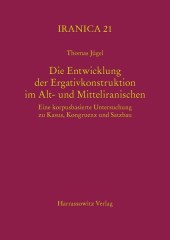 Jügel, Thomas. 2015. Die Entwicklung der Ergativkonstruktion im Alt- und Mitteliranischen. Eine korpusbasierte Untersuchung zu Kasus, Kongruenz und Satzbau (Iranica 21). Wiesbaden: Harrassowitz Verlag.
Jügel, Thomas. 2015. Die Entwicklung der Ergativkonstruktion im Alt- und Mitteliranischen. Eine korpusbasierte Untersuchung zu Kasus, Kongruenz und Satzbau (Iranica 21). Wiesbaden: Harrassowitz Verlag.Ergativity is a grammatical phenomenon that has been discussed controversially in linguistics in general and in the Iranian Studies in particular. The scientific debate is characterized by a lack of consideration of the Old and Middle Iranian data. In many cases, the selected examples, which their position in the respective language system is still unclear, are associated with theory-driven assumptions about a hypothetical model of development, which is to be plausible, but not verifiable.
The present study provides a solution through the complete analyzing of the Avestan , Old Persian, Bactrian and Parthian documents as well as an extensive study of Middle Persian evidences (approximately 12,500 Middle Persian cases). In addition to the relevant ergativity aspects such case, congruence, word order, and reflexivity both the development of syntactic structures (e.g. relative clauses) as well as the verbal and nominal system (e.g. the temporal aspect system or the function of enclitic personal pronouns) are discussed .
Results are illustrated with relevant evidences (over 1,400 examples alone in the main part), whose validity is constantly checked and based critically on detailed philological discussion. The material part also serves as a vademecum, which can be used in parallel with the reading of the main part, as well as a separate reference book that systematically illustrates the history of the object in ergative languages.
The volume presents the most exhaustive investigation on ergativity in within the Old and Middle Iranian languages.
The detaild Table of Content of this book and the English Summery are availabe.

 Parthian Sources Online
Parthian Sources Online Durkin-Meisterernst, Desmond. 2014.
Durkin-Meisterernst, Desmond. 2014.  Olbrycht, Mark Jan. 2014. Parthians, Greek culture, and beyond. In Twardowska, Kamilla, Maciej Salamon, Sławomir Sprawski, Michał Stachura & Stanisław Turlej (eds.), Within the circle of ancient ideas and virtues. Studies in honour of Professor Maria Dzielska, 129–142. Kraków.
Olbrycht, Mark Jan. 2014. Parthians, Greek culture, and beyond. In Twardowska, Kamilla, Maciej Salamon, Sławomir Sprawski, Michał Stachura & Stanisław Turlej (eds.), Within the circle of ancient ideas and virtues. Studies in honour of Professor Maria Dzielska, 129–142. Kraków.